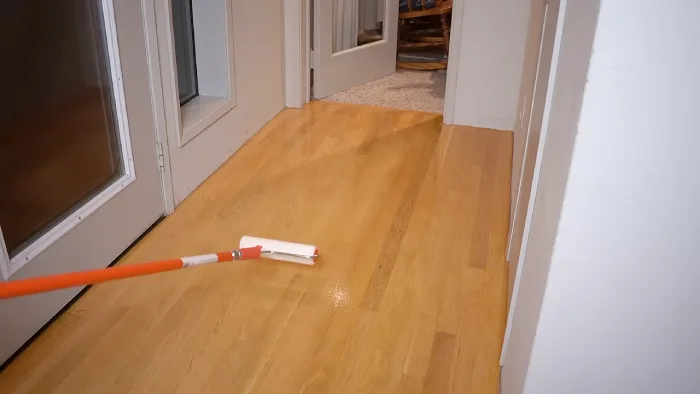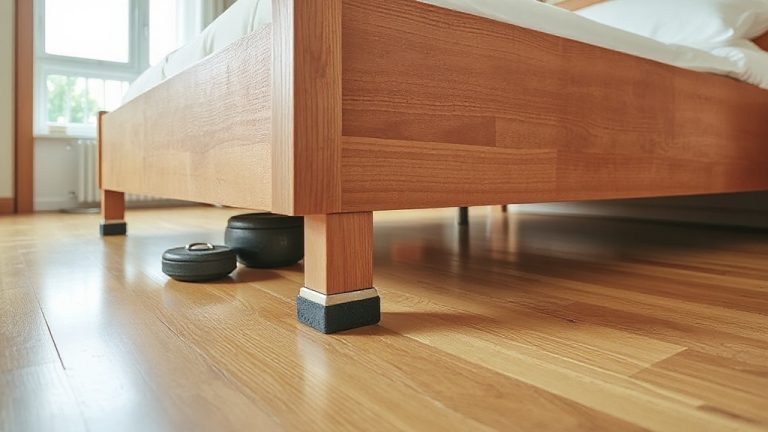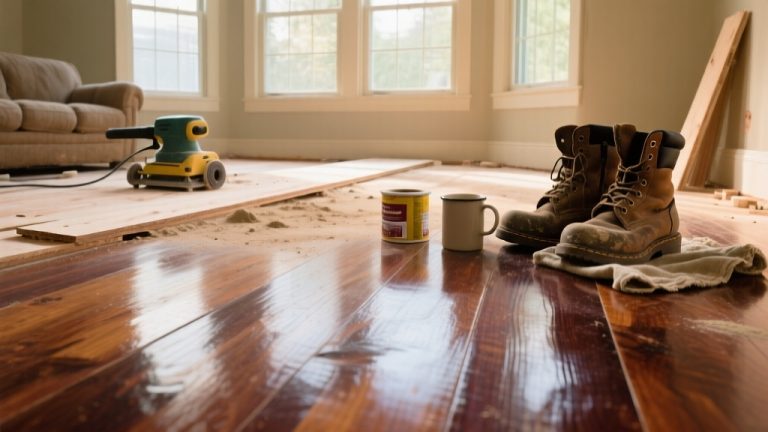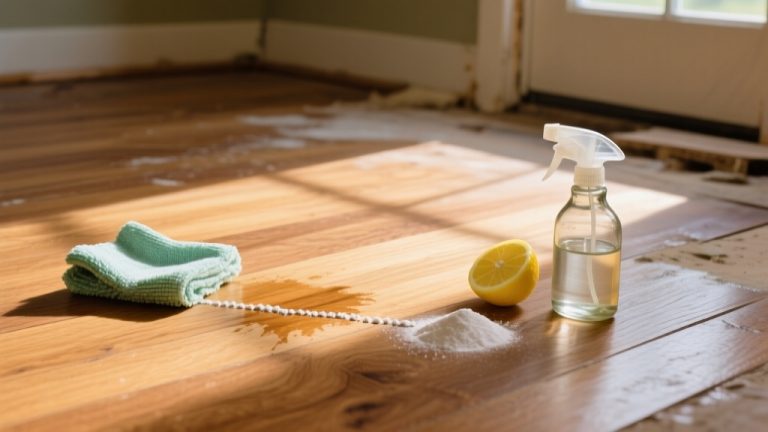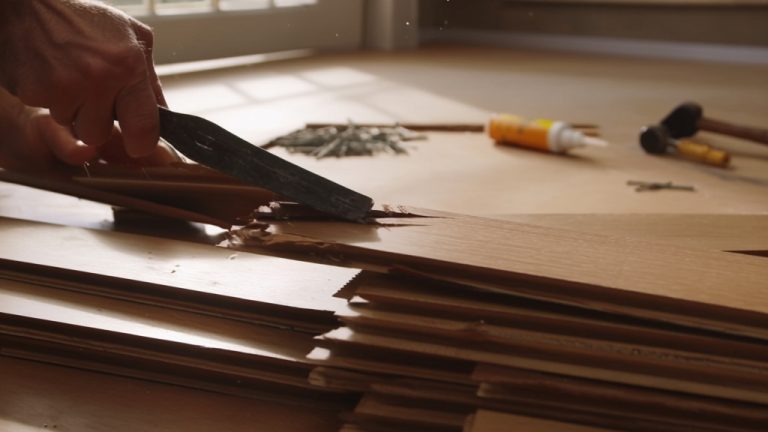Should You Paint Before or After Refinishing Hardwood Floors: Know the Truth
Are you planning on refinishing your hardwood floors and giving your walls a fresh coat of paint? It’s a great way to give your home a new look, but you may be wondering whether you should paint before or after refinishing your floors.
The answer is that it’s best to paint after refinishing your hardwood floors. There are several reasons for this.
To begin with, refinishing hardwood floors can be messy, and dust and debris will likely be kicked up during the sanding and staining process. You will have to clean and touch up your freshly painted walls if you paint them before refinishing your floors.
Throughout this article, we will discuss some of the reasons why it’s a good idea to paint after refinishing your hardwood floors.
Why Should You Paint Walls After Refinishing Hardwood Floors?
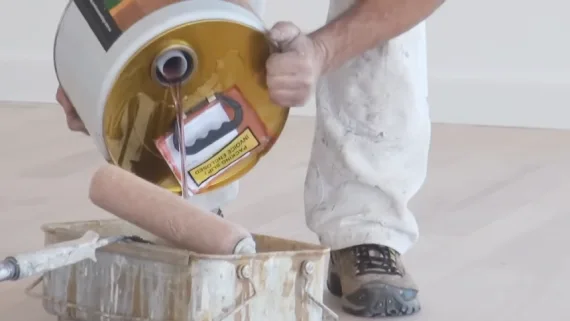
If you plan to refinish your hardwood floors, consider painting your walls afterward. Not only will this protect your newly refinished floors from any accidental spills or drips, but it will also make cleanup much easier. Here are some of the main reasons:
- No 01: Protecting the Floors
- No 02: Easier Cleanup
- No 03: Minimizing Wall Damage
- No 04: Avoiding Dust Accumulation
- No 05: Coordinated Aesthetics
- No 06: Ease of Repair and Maintenance
No 01: Protecting the Floors
When you refinish hardwood floors, you want to ensure that the newly finished surface remains pristine for as long as possible. Painting the walls after refinishing allows you to prioritize protecting the floors, which are far more difficult to cover than other surfaces.
With drop cloths or protective sheets, you can rest assured that your floors will remain unscathed by any paint spills or drips. It’s a simple step that can make a huge difference in the longevity of your newly refinished floors.
No 02: Easier Cleanup
With the walls painted after refinishing, you’ll find cleaning up any stray paint drips or spills on the floor to be a breeze. Here are three reasons why:
Freshly refinished floors are easier to clean
With no protective coating yet applied, the surface of your newly refinished floors is smooth and easy to wipe clean. This means that any paint drips or spills can be quickly cleaned up without leaving lasting marks or stains on the floor.
You have more control over the painting process
When you paint the walls before refinishing the floors, you run the risk of accidentally getting paint on the finished surface. However, when you paint the walls after refinishing, the process is more controlled, and you can avoid getting paint on the floor altogether.
It saves time and money
Painting the walls after refinishing the floors saves you time and money on repairs. If you accidentally drip paint on the finished floor during the painting process, you may need to hire a professional to repair the damage. However, by painting the walls after refinishing, you can avoid this costly mistake altogether.
No 03: Minimizing Wall Damage
By avoiding the risk of damaging your freshly painted walls, you can enjoy the beauty of your newly refinished floors without any worries.
To minimize wall damage when installing quarter-round or other moldings along the baseboards, it’s best to paint the walls last. This way, you won’t have to worry about accidentally scratching or marking the walls while installing the moldings.
Painting the walls last also allows you to complete the floor refinishing process without any disruptions. You can focus solely on refinishing the floors without worrying about protecting the walls or cleaning up any accidental marks.
This makes the entire process easier and more efficient, ensuring you have beautiful floors and pristine walls.
No 04: Avoiding Dust Accumulation
To keep your walls looking clean and smooth, don’t forget to take steps to avoid dust accumulation during the hardwood floor refinishing process. One effective way to do this is to paint your walls after refinishing your floors.
Sanding the surface of your hardwood floors generates dust particles that can settle on your walls, causing unsightly blemishes and making your freshly painted walls look dirty. As a result, you’ll need to do some extra work after sanding.
By painting your walls after refinishing your floors, you can prevent this from happening and maintain a clean and smooth finish on your walls.
In addition to painting your walls after refinishing your floors, you can also take other steps to avoid dust accumulation. For example, you can cover your furniture, windows, and other surfaces with plastic sheeting to protect them from dust.
No 05: Coordinated Aesthetics
One of the most significant advantages is achieving a coordinated aesthetic that creates a visually pleasing look in the room.
By refinishing the floors first, you can easily match the paint shades to complement the wood tones. This coordination between the wall color and the floor’s tone creates a cohesive look that ties the room together.
Whether you want a warm, inviting atmosphere or a modern and chic vibe, the coordinated aesthetics will help achieve your desired style.
No 06: Ease of Repair and Maintenance
Maintaining the appearance of your walls and floors is essential, and the ease of repair and maintenance is an important factor to consider when choosing the order of refinishing and painting. Here are three factors that make it better to paint hardwood floors after refinishing them:
- Accidental damage during the refinishing process is a common occurrence. If the walls are already painted, it’ll be easier to patch and repaint small areas than to repair the floors.
- Painting the walls last will give you the flexibility to address any necessary touch-ups or repairs without the added complexity of dealing with the floor finish. This will ensure that your walls and floors look pristine and coordinated for a longer period.
- Lastly, if you paint before refinishing the floors, the floor refinishing process may cause damage to your newly painted walls. This will require additional time and money to fix, increasing the project’s overall cost.
How long does it take for wood floors to dry after refinishing?
After refinishing hardwood floors, the wood can feel as dry as the Sahara desert. However, it’s important to note that the drying process can take longer than you might think.
Each coat of oil-based finish takes 24 hours to dry, and if you’re staining the wood, it can take 24 hours or longer to dry too. This means that you should expect the refinishing process to take a minimum of three days.
If you’re using water-based finishes, the drying time can be shorter, taking about two days to refinish hardwood floors fully. However, it’s important to allow enough time for the floors to dry completely before moving furniture or allowing foot traffic.
Rushing the process can lead to damage to the newly refinished floors. So, be patient and allow the floors to dry fully before moving on to the next step in the process.
Can you live in the house while refinishing hardwood floors?
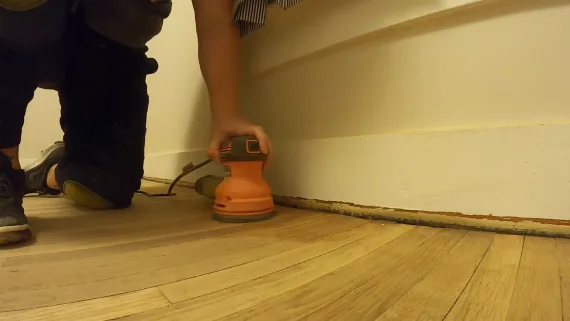
While refinishing hardwood floors, it’s not advisable to live in the house due to the fumes/off-gassing. So, it’s better to find alternative accommodations for at least two days. The fumes and dust generated during the refinishing process can cause respiratory problems and other health issues.
Avoiding these risks by staying out of the house until the job is complete and the floors are fully dried. If you’re wondering where to stay while your floors are being refinished, consider staying with friends or family or booking a hotel room.
While leaving your home for a few days may be inconvenient, it’s worth the peace of mind knowing that you and your family are safe from the harmful chemicals used during the refinishing process.
In addition, the professionals will have ample time to complete the job without interruptions, resulting in a beautiful and long-lasting hardwood floor.
How do I protect the hardwood floors while painting the walls?
Use drop cloths or protective sheets securely taped or weighted down during wall painting to keep your hardwood floors safe from paint spills and damage. This is a crucial step in protecting the floors, especially if you’re using a roller or spray paint.
Ensure that the drop cloths or protective sheets cover the entire floor area and aren’t moved during the painting process. You can use duct tape or painter’s tape to secure the edges of the drop cloths to the baseboards or walls so they don’t move.
Additionally, inspecting the drop cloths or protective sheets for any holes or tears before use is essential. If you notice any damage, replace them with new ones.
You can also use plastic sheeting, which is an excellent alternative to drop cloths, but it can be slippery, so be cautious when walking on it.
Transform Your Home with Flawless Walls and Stunning Hardwood Floors
If you plan to paint your walls and refinish your hardwood floors, it’s recommended to paint the walls after refinishing them. This is because sanding and staining the floors can generate dust that can settle on the walls, affecting the paint’s finish.
Additionally, painting after refinishing the floors gives you the opportunity to match the color and style of your walls to the new look of your floors.
Before painting, it’s crucial to thoroughly dry the floors. This can take anywhere from 24 to 72 hours, depending on the type of finish and the humidity levels. It’s also essential to take precautions to protect the floors from paint spills and splatters, such as using drop cloths and painter’s tape.
Therefore, patience and attention to detail are key when refinishing hardwood floors and painting walls to achieve the best results. By following the proper steps and taking the necessary precautions, you can create a stunning and cohesive look for your home.
Remember, a little extra effort can go a long way in achieving your desired outcome.

